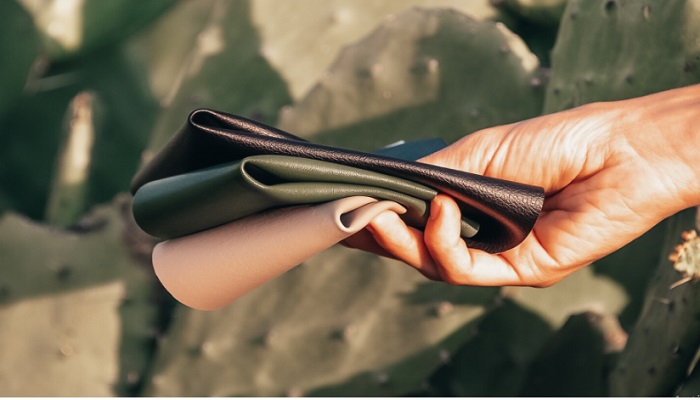For generations, leather has been associated with classic elegance and superior quality. The leather business is using contemporary technologies to maintain the beauty and ethical production of this beloved material.
This fascinating voyage investigates how the most recent technical advancements may revolutionize the leather industry, reduce their negative effects on the environment, and open the door to a sustainable future.
Utilizing Contemporary Technology to Promote Environmental Sustainability in the Future
The skill and long history of leather goods making are going through a tremendous metamorphosis that is pushing the limits of conventional design and usefulness. With customers becoming more environmentally aware, the fashion sector, in particular, is taking a radical new approach to sustainability. It makes an effort to drastically lessen its effect on the environment while maintaining the beauty and ethical production of this prized raw resource.
Sustainable leather manufacturing and leveraging technology developments within the leather sector are essential to this change. Improvements in natural chemistries reduce the chemical footprint of tanneries. Vegetable tanning, for instance, provides a chrome-free method. This shapes environmentally sustainable production processes while enabling the preservation of traditional leather workmanship.
Furthermore, the development of biofabricated materials presents a cutting-edge, environmentally friendly substitute for conventional leather items.
To develop unique textures and designs, leather makers are embracing cutting edge technologies like bioprinting and 3D printing with enthusiasm. The utility and design of leather goods are radically altered by these technologies.
They use laser cutting for similar creative purposes as well. By adding sensors, integrating technology pushes traditional leather even farther. These developments might, for instance, make it possible to produce leather items that are more breathable, weather resistant, or durable while also addressing environmental issues such excessive wastewater produced during manufacture.
Even more revolutionary are smart technologies. Artificial intelligence (AI) and automated monitoring systems provide outstanding effectiveness, unmatched consistency, and quality control. By drastically cutting waste and production time, these technologies enable more ecologically responsible manufacturing. This is consistent with the circular economy’s emphasis on reducing waste, reusing materials, and extending product lifecycles.
For instance, by using AI to optimize cutting procedures, a manufacturing process might reduce waste during processing. In order to extend the life of products and decrease the need for replacements, smart sensors integrated into leather goods may also monitor wear patterns and sound an alarm for prompt repairs.
The sector is anticipated to develop quickly as demand for sustainable leather items rises. Because of its natural characteristics, leather fits well with current production trends by paving the way for cutting-edge product designs, materials, and technology.
With technology reshaping the leather products sector, there is a great deal of opportunity for a more environmentally friendly future. Augmented reality (AR) and virtual reality (VR) applications might further expand the possibilities of the sector.
What Does the Leather Industry’s Future Hold?
The future of the sector is probably shaped by the rising need for environmentally friendly solutions. In addition to wanting a product they can feel good about purchasing, consumers also desire the appearance and feel of leather. Furthermore, future developments in AR and VR may improve the in-store experience for customers even more. Imagine utilizing augmented reality (AR) to digitally try on leather apparel or customize a leather purse in real time. VR tours of environmentally friendly leather farms or production plants might promote brand confidence and transparency.
The leather industry is predicted to reach $700 billion by 2030 as a result of this growth. This rise is driven by both new and authentic synthetic alternatives.
For individuals who care about animal welfare, plant-based alternatives produced from apple or mushroom skin provide an alternative devoid of animal suffering. These vegan substitutes aren’t ideal, however. Many are combined with chemicals derived from petroleum, which during extraction and refining may be harmful to the environment.
Here are two of the best plant-based products available right now.
- Stella McCartney’s MyloTM is a ground-breaking substance made from mycelium, the fungal root structure.
- AppleskinTM: Apple SkinTM is an eco-friendly and cruelty-free substitute for leather, made from leftover apples.
How Could Production Become More Eco-Friendly?
To save the environment, lower greenhouse gas emissions, and lessen carbon footprint, an ecologically friendly wave of innovation is laying the groundwork for a more environmentally friendly future.
Real leather manufacturing has greatly reduced its environmental impact while retaining quality and attractiveness by enacting stronger environmental rules and enforcing compliance with them.
To this end, the sector is concentrating on a number of important areas.
Cutting Down on Resource Usage
Reducing resource use requires creative solutions like rainwater collecting and energy-efficient machines. Tanners may also reuse raw materials and water by using chromium-recovery systems and waterless tanning procedures, which further reduces their environmental effect.
Emphasis on Sustainable Raw Materials
One of the most effective strategies to increase the sustainability of leather is to get animal skins from regenerative farms. These farms rotate livestock and crops on the same area, giving priority to soil health, biodiversity, and sequestering carbon dioxide. Reusing leftover materials to create new goods reduces waste and the demand for virgin hides at the end of the process.
Encouraging a Sustainable Economy
The cyclical process is embodied in real leather itself. As a byproduct of cattle produced for food, hides are derived from a renewable resource. If the final product is sustainably tanned, it may survive for generations and biodegrade at the end of its life. Further optimization of tanning chemistry may improve biodegradability and provide a secure breakdown process.
From Nature & Beyond, round
Natural leather offers long-lasting resilience by using skins from the meat industry. Wearing leather may be recycled or repurposed into new goods, prolonging its lifespan, and eco-friendly tanning encourages biodegradability.
Novel, Cutting-Edge Remedies
Innovative technologies that limit waste, lessen environmental impact, and advance a circular economy are what propel the transition to sustainability.
Here are few instances:
- Advanced Tanning Techniques: Compared to conventional chrome tanning, these techniques—vegetable and enzyme-based tanning—use less chemicals and result in a more environmentally friendly manufacturing process.
- Bio-based Materials: New materials with different sustainability tradeoffs, such as AppleskinTM (apple waste leather) and MyloTM (mushroom leather), are based on plants and do not involve animal testing.
- Repurposed leather: By using leftover leather, less leather is wasted and virgin hides are needed.
- Nano-coatings for Increased Durability: These shielding layers may prolong the life of leather goods, lowering the need for replacements and cutting down on waste.
- Encouraging Customers: Accurate and transparent laws governing leather labeling enable you to make knowledgeable decisions regarding the sustainability of the traditional leather goods you buy. This contains details on the product’s origin, tanning method, and any possible sustainability certifications.
Advanced Techniques for Tanning
In the process of producing leather, tanning transforms unfinished skins into long-lasting goods. Conventional tanning techniques often use a lot of chemicals, which may harm the environment and contaminate water supplies. Nonetheless, the industry is adopting cutting-edge technology solutions that offer a healthier and more ecologically friendly method of tanning, such as microbial tanning and ultrasound. These methods minimize the effect on the environment by drastically reducing the need for harsh chemicals and water.
Future-Generation Solutions for Tanning
The introduction of novel next-generation tanning options such as microbiological and ultrasonic tanning is one notable development.
Ultrasound tanning: This method greatly reduces the need for water and harsh chemicals by treating animal hides with sound waves.
By using bacteria or fungus to break down proteins, microbial tanning reduces the requirement for synthetic tanning agents by functioning as natural tanning agents.
Lab-grown or cultured leather
Conventional leather manufacturing has negative environmental effects and may be resource-intensive. An interesting substitute is cultured leather, which is made by cultivating leather in a lab using animal cells.
This lessens the need for animal skins and provides a cruelty-free substitute that satisfies consumers’ increasing desire for green goods. In a future when raw animal skins are hard to come by yet genuine leather is still wanted, lab-grown leather would be a terrific alternative.
But because more than 100 million hides from animals processed for the meat industry are disposed of in landfills annually, there is a clear chance to wisely use this resource by turning it into genuine leather.
How Lab-Grown Cultured Leather Operates:
Production method: A tiny number of animal cells are taken out, cultivated in a laboratory, and finally create a sheet of collagen that resembles human skin. This sheet of collagen may then be turned into leather using conventional tanning techniques.
Potential: By drastically lowering the environmental effect of farming and cattle raising, together with possible advantages for animal welfare, cultured leather has the potential to revolutionize the market for ecologically friendly leather.
Prospects for the future: Although the technology seems promising, further development is needed to bring it into compliance with product requirements and to scale it up for wider use.
Cultured leather has a lot of promise. Cultured, lab-grown leather would be the closest thing to the real thing for customers who really desire vegan leather.
But the adoption of cultured leather is just at the start of its journey. Although the findings have been encouraging, further testing and refinement of the methodologies are required to demonstrate production scalability. Nonetheless, given its potential and the leather industry’s dedication to innovation, cultured leather has the potential to significantly influence how the leather industry develops in the future.
Until then, it’s critical that we appreciate and use the whole animal, including its hide, to minimize waste from our food sources as a whole, even if beef production continues to be an inexpensive, nutrient-dense protein supply for the majority of the world.
Defining Synthetics More Broadly: The Emergence of Plant-Based Leather Substitutes
Conventional synthetic leather alternatives, which are often composed of polyvinyl chloride (PVC) and polyurethane (PU), might have negative aspects including reduced breathability and environmental issues. The definition of synthetic leather is growing beyond these conventional materials as the industry experiences a major transition with higher standards of quality. The fake plant substitutes made of cactus, apples, and mushrooms are becoming more and more popular, which is a testament to the industry’s dedication to sustainability and innovation.
These “eco-friendly” substitutes made of organic ingredients demonstrate the industry’s readiness to broaden the supply chain for synthetic leather.
On the other hand, it’s critical to recognize greenwashing in plant-based products. Certain corporations may highlight their use of natural resources while keeping their use of petroleum-based binders and resins hidden, which may reduce the product’s overall environmental friendliness.
Plant-based substitutes have possibilities in the future as the industry develops synthetics further, as they embrace a wider definition of synthetics that includes natural and renewable resources.
A Greener Leather Manufacturing Future
The industry has historically been under investigation for its effects on the environment. But the way leather is made is changing toward a more conscientious future due to a movement in production toward ecologically friendly methods, such as following more legal requirements. Looking forward, the industry’s future seems to be built on innovation, sustainability, and long-lasting attractiveness.
The industry is adopting sustainable processes, emphasizing environmental responsibility and ethical sourcing, including the use of recycled and cultured leather, in response to the growing customer demand for eco-friendly materials and products.
Through their patronage of companies dedicated to eco-friendly innovations, customers have significant influence on the trajectory of the leather industry. There are several avenues for customers to effect change. It’s a good idea to check for certifications from respectable groups like the Leather Working Group or look up firms’ sustainability pledges on their websites. A world full of varied leather goods that satisfy our need for style while still adhering to our moral and environmental principles is ahead of us.
Important lessons learned
Sustainability cannot be an afterthought in the leather sector as it is at a turning point. A shift is occurring, driven by changing consumer attitudes and environmental requirements. Manufacturers are using cutting-edge tanning methods, lab-grown cultured leather, and plant-based substitutes to lessen their environmental impact without sacrificing the classic beauty of leather.
But this environmental movement is more important than just the leather sector. It serves as a little example of how urgently advancements in sustainability and transparency must be adopted in order to protect the earth’s limited natural resources for coming generations. Now that leather is so intricately entwined with our culture, it has the chance to lead the way in ethical manufacturing methods.
Clearly, achieving this environmentally friendly goal will call for a concerted effort from manufacturers, customers, and brands. Companies need to put much more money into environmentally friendly technology. It is essential for manufacturers to integrate optimal methodologies throughout their supply chains. Perhaps most importantly, however, is that customers need to utilize their buying power to support businesses that really put ethics and the environment ahead of greenwashing.
Although there will be challenges along the way, the end goal is obvious: to transform the way we experience leather while using the limited resources of our world as little as possible. Through a collaborative acceptance of sustainability as the new standard, the leather industry can create a lasting legacy of opulent luxury without compromising our environmental ethics. Explore the sustainable leather manufacturers that are leading this transition. The future is now.



































